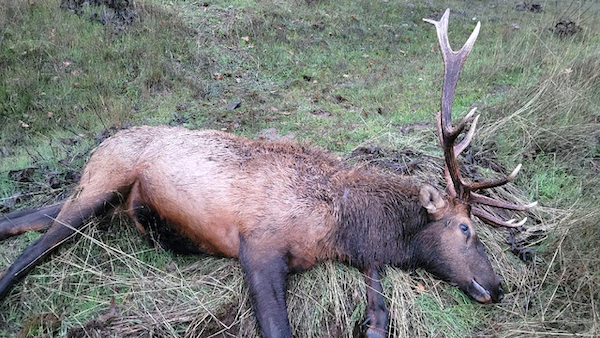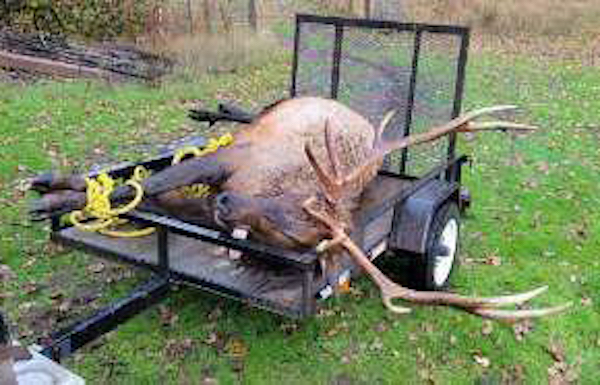Gorge Duo Fined $16,000 Over Poached Trophy Elk
THE FOLLOWING IS AN EXTENDED-CUT PRESS RELEASE FROM THE OREGON DEPARTMENT OF FISH AND WILDLIFE
Poachers will pay $16,000 in fines and restitution for killing a trophy elk near Mosier in 2021, according to OSP Fish and Wildlife officials. The member of the public who texted OSP F&W Troopers to report a suspicious photo circulating on social media earned five hunter preference points.
Lionardo Munoz, of Mosier, will pay over $15,000 in fines and fees for shooting the 6X6 bull elk. Matt Wilkinson, also of Mosier, will pay $1,000 in fines related to concealing the crime. The investigation also revealed at least one buck deer that Wilkinson’s wife, Rachel Hallett, had poached. Hallett was sentenced to community service.Additional penalties for the three include bench probation, forfeiture of meat and heads, and hunting suspensions.

The incident started on Nov. 9, 2021, when a hunter texted a photo circulating on social media to OSP F&W Troopers. Something was just not right about the photo of a 6X6 bull elk on a trailer.
Senior Trooper Brent Ocheskey, based in The Dalles, received the text, and called the hunter. He had his own questions about the photo.
“It was a big elk on that trailer,” Senior Trooper Ocheskey said, “An elk is a big animal, not easy to pack out without gutting and quartering it. That in itself was suspicious, especially in our patrol area.”
Senior Trooper Ocheskey got a name of a possible hunter who had harvested the elk. After some quick research, he contacted Senior Trooper Matt Newby as backup and the two headed to the subject’s residence.
No one was home at Lionardo Munoz’ house. As the troopers drove away, they saw a truck turn down the drive. In the back of the trucks was a 6X6 bull elk head along with the hide. They had located the hunter in question, and the bull.
Munoz had a tag for a spike elk, and it appeared his crime was taking an over-sized elk. But Munoz said the elk belonged to his friend and passenger in the truck, Matt Wilkinson. Wilkinson said his wife, Rachel Hallett, had shot it earlier in the Santiam unit.
Wilkinson even showed the troopers a location pin on his OnX map hunting app. The troopers knew the pinned location was an area of the Bull Run watershed that is off limits to hunting. Further, the high country was blanketed in fresh snow, an obstacle Wilkinson denied encountering. The contact continued at Munoz’s residence.
Senior Trooper Ocheskey asked if there were any photos. Wilkinson said no. The Trooper, a seasoned hunter, knew that when hunters land big animals, they want photos. And he had seen the photo that came in with the initial report. As the story got further from the truth, the details and issues surrounding the harvest entangled themselves to a point that is it was obvious something was wrong.
Senior Trooper Ocheskey thought it was time to speak to Hallett.
Wilkinson agreed to call his wife, Rachel Hallett, who spoke with Wilkinson and then answered the Troopers’ questions. Hallett was quick to agree with her husband and insisted she shot the elk in the Santiam unit. But unlike the usual excitement and retelling of a story one would expect with a large animal, her replies were short. And with little detail. Senior Trooper Ocheskey asked if she had any photos. Yes, she said, her husband Matt and their friend, Lio Munoz, had photos. This was a big break because just moments before there had been no photos of the hunt, according to Munoz and Wilkinson.
Munoz opened the photos on his phone. The first photo he showed Senior Trooper Ocheskey was that of Wilkinson sitting on top of the dead bull’s back, holding both sides of the antlers. Hallett was in none of the photos and then terrain and foliage consisted of dry grass and oak trees, and not snow and a fir covered national forest. Munoz was quick to dismiss his involvement and said he had only helped load the animal.

After looking at the photos, Senior Trooper Ocheskey confronted Wilkinson with the facts. Wilkinson admitted that the bull was not killed in the Santiam unit and was killed locally in the White River unit on private property.
Neither Hallett, Munoz nor Wilkinson had the appropriate tag for the elk. Although Senior Trooper Ocheskey still did not believe Hallett had killed the bull, Wilkinson and Munoz maintained that part of the story, saying she had killed the bull. After learning of the true location where the bull was killed, Munoz didn’t want the Troopers at his house and asked that they leave. The elk head and hide were seized.
Another call was made to Hallett, who offered no new information.
Senior Troopers Ocheskey and Newby continued their conversation with Wilkinson down the road. Wilkinson surprised them by saying his wife would be unwilling to continue the lie. Wilkinson wanted to tell the truth.
Wilkinson said Munoz shot the elk in an orchard in Mosier. The two men retrieved Munoz’s trailer to load the carcass.
But they had a problem: Meat processors will not take game animals without the proper hunting tag. Munoz had a spike tag. Wilkinson remembered that his wife had a tag for a bull elk in the Santiam unit. They would use that instead.
Wilkinson drove into town, located his wife, borrowed her phone, and validated her electronic tag from her account notifying ODFW that she had shot an elk in the Santiam unit. Then he instructed her to follow along with the story if anyone asked. Later in the season, if Hallett shot a spike, Munoz would return the favor by letting her use his spike tag.
None of them had been where they said they shot the elk. Instead, Wilkinson had admitted that the pin from on OnX that he had shown Senior Trooper Ocheskey earlier in the day was a likely spot to scout. He had never been there and didn’t know it was in the Bull Run watershed
Wilkinson called Munoz to let him know the truth was out. Both men apologized for their actions and Senior Trooper Ocheskey cited Munoz for the Unlawful Take of the Six Point Bull Elk and Wilkinson for aiding in the violation.
“Whether by design, negligence or forgetfulness, sometimes people don’t take regard for which tag they have,” Senior Trooper Ocheskey said, “But then they get in the weeds trying to cover their tracks instead of reporting their mistake. Or they are intentionally deceitful. They loan and borrow tags. And that’s what gets people in trouble.”
In the following days Senior Trooper Ocheskey continued his investigation. Wilkinson and Hallett were not out of the woods yet. In reviewing hunting records, the troopers learned Hallett had reported killing a deer in the Santiam unit the month before. But the tag was not date and time stamped.
Senior Trooper Ocheskey decided to drive to the Wilkinson home to follow up. When he pulled into the drive, both Wilkerson and Hallett were in the front yard.
“When they saw me pull in, Hallett went around to the back of the house,” Senior Trooper Ocheskey said. Wilkinson came over to talk.
Senior Trooper Ocheskey asked about the deer Hallett harvested back in October. Wilkinson admitted that Hallett had shot it in an orchard near their house. When Senior Trooper Ocheskey pointed out they would have needed a White River unit tag, Wilkinson adjusted his story. He eventually admitted to buying a left over Western Oregon deer tag, going on the hunt with Hallett, and then realizing they were outside the hunt unit after the fact. Wilkinson admitted to tagging and reporting Hallett’s buck for the Santiam unit because she did not understand the units.
While at the residence Senior Troopers Ocheskey and Newby learned that Wilkinson was in possession of three additional deadheads from buck deer. Wilkinson said a friend gave him one of the heads. The other two were from a dead deer he had found and a roadkill. Senior Troopers Ocheskey and Newby seized all four deer heads and the meat from the Hallett’s buck. Troopers issued warnings to Wilkinson for unlawful possession of wildlife parts and cited Hallett for illegal take of a buck deer. Wilkinson was again cited for aiding in a wildlife offense.
The good Samaritan who reported the elk on the trailer received five hunter preference points: Four were for the original elk report, and one point for the subsequent buck deer.
Bernadette Graham-Hudson, ODFW Wildlife Administrator, is encouraged by the outcome of the case.
“Oregon hunters, legislators and other conservationists worked hard to pass strict sentencing guidelines to address poaching cases like this one,” Graham-Hudson said, “Hopefully fines like this will serve as a warning to others who would behave so irresponsibly”
“It is great that hunters and members of the public are willing to call in what they see so we can protect the wildlife and make cases that would otherwise be undetected,” Senior Trooper Ocheskey said.
“We rely on the public and the sportsmen and women who call in the tips on what they see. These tips are very important because we patrol vast areas of the state and just can’t be everywhere at once. Sometimes tips lead to really good cases like this one. Sometimes a tip solidifies a case we are already working. Sometimes the tip results in no case or a mistaken violation but that’s okay too. Every case is different, and all information is appreciated because you never know. It’s a Trooper’s jobs to figure out what we have once we get a call”.
Yvonne Shaw, Stop Poaching campaign coordinator with ODFW, agrees.
“Poachers steal from all Oregonians,” she said. “This is an excellent example of how OSP F&W Troopers work through a case and find the truth.”
The outcome of those hearings is as follows:
Matthew Wilkinson, 38, of Mosier, pleaded guilty to Unlawful Take of a Six-Point Bull Elk & Unlawful Take of a Buck Deer. Defendant’s sentence included:
- 12 months of bench probation
- 40 hours of community service
- A three year hunting license suspension on one count, concurrent with a five year hunting license
suspension on the other count - $1000 compensatory fine to ODFW for the elk
- Forfeiture of the seized wildlife
- Forfeiture of all hunting licenses and tags
Lionardo Munoz pleaded guilty to Unlawful Take of a Six Point Bull Elk. Defendant’s sentence included:
- 18 months of bench probation
- Three year hunting license suspension
- Forfeiture of the seized wildlife
- Forfeiture of all hunting licenses and tags
- $15,000 compensatory fine to ODFW for the elk
- $431.25 reimbursement to OSP for cut-and-wrap costs of elk
Rachel Hallett pleaded guilty to Unlawful Take of Buck Deer. Defendant’s sentence included:
- 12 months of bench probation
- Three year hunting license suspension
- Forfeiture of seized wildlife
- Forfeiture of all hunting licenses and tags
- 40 hours of community service
If you know of or suspect other crimes against fish, wildlife or habitat, please report to the Turn In Poachers (TIP) Line. 1-800-452-7888 or *OSP (*677) from a mobile phone. Or email: TIP@osp.oregon.gov between the hours of 8-5 Mon-Fri.
The Stop Poaching Campaign educates the public on how to recognize and report poaching. This campaign is a collaboration among state agencies, sportsmen and other conservationists, landowners, and recreationists to engage the public in combatting Oregon’s poaching problem. Our goal is to: Incentivize reporting on wildlife crimes through the TIP Line; Strengthen enforcement by increasing the number of OSP Fish and Wildlife Troopers; and Support prosecution in becoming an effective deterrent. The campaign helps to protect and enhance Oregon’s fish and wildlife and their habitat for the enjoyment of present and future generations. Contact campaign coordinator Yvonne Shaw for more information. Yvonne.L.Shaw@odfw.oregon.gov.
